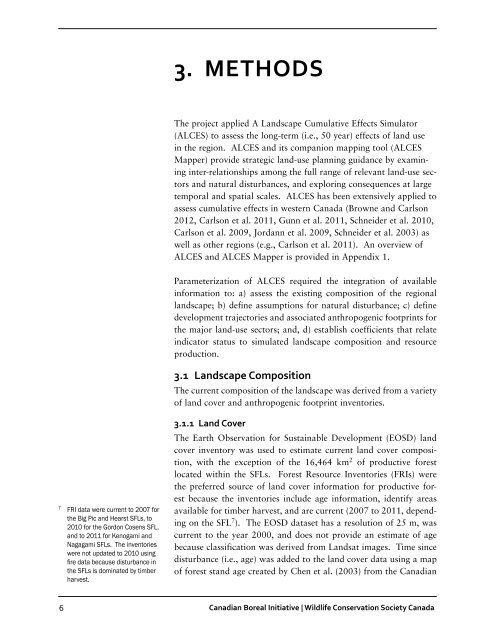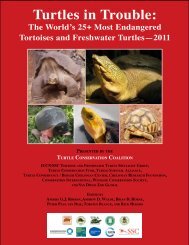Create successful ePaper yourself
Turn your PDF publications into a flip-book with our unique Google optimized e-Paper software.
3. Methods<br />
The project applied A Landscape Cumulative Effects Simulator<br />
(ALCES) to assess the long-term (i.e., 50 year) effects of land use<br />
in the region. ALCES and its companion mapping tool (ALCES<br />
Mapper) provide strategic land-use planning guidance by examining<br />
inter-relationships among the <strong>full</strong> range of relevant land-use sectors<br />
and natural disturbances, and exploring consequences at large<br />
temporal and spatial scales. ALCES has been extensively applied to<br />
assess cumulative effects in western <strong>Canada</strong> (Browne and Carlson<br />
2012, Carlson et al. 2011, Gunn et al. 2011, Schneider et al. 2010,<br />
Carlson et al. 2009, Jordann et al. 2009, Schneider et al. 2003) as<br />
well as other regions (e.g., Carlson et al. 2011). An overview of<br />
ALCES and ALCES Mapper is provided in Appendix 1.<br />
Parameterization of ALCES required the integration of available<br />
information to: a) assess the existing composition of the regional<br />
landscape; b) define assumptions for natural disturbance; c) define<br />
development trajectories and associated anthropogenic footprints for<br />
the major land-use sectors; and, d) establish coefficients that relate<br />
indicator status to simulated landscape composition and resource<br />
production.<br />
3.1 Landscape Composition<br />
The current composition of the landscape was derived from a variety<br />
of land cover and anthropogenic footprint inventories.<br />
7<br />
FRI data were current to 2007 for<br />
the Big Pic and Hearst SFLs, to<br />
2010 for the Gordon Cosens SFL,<br />
and to 2011 for Kenogami and<br />
Nagagami SFLs. The inventories<br />
were not updated to 2010 using<br />
fire data because disturbance in<br />
the SFLs is dominated by timber<br />
harvest.<br />
3.1.1 Land Cover<br />
The Earth Observation for Sustainable Development (EOSD) land<br />
cover inventory was used to estimate current land cover composition,<br />
with the exception of the 16,464 km 2 of productive forest<br />
located within the SFLs. Forest Resource Inventories (FRIs) were<br />
the preferred source of land cover information for productive forest<br />
because the inventories include age information, identify areas<br />
available for timber harvest, and are current (2007 to 2011, depending<br />
on the SFL 7 ). The EOSD dataset has a resolution of 25 m, was<br />
current to the year 2000, and does not provide an estimate of age<br />
because classification was derived from Landsat images. Time since<br />
disturbance (i.e., age) was added to the land cover data using a map<br />
of forest stand age created by Chen et al. (2003) from the Canadian<br />
6 Canadian Boreal Initiative | Wildlife Conservation Society <strong>Canada</strong>







![RaLand / SeaScape [PDF] - Wildlife Conservation Society](https://img.yumpu.com/49974326/1/190x245/raland-seascape-pdf-wildlife-conservation-society.jpg?quality=85)









